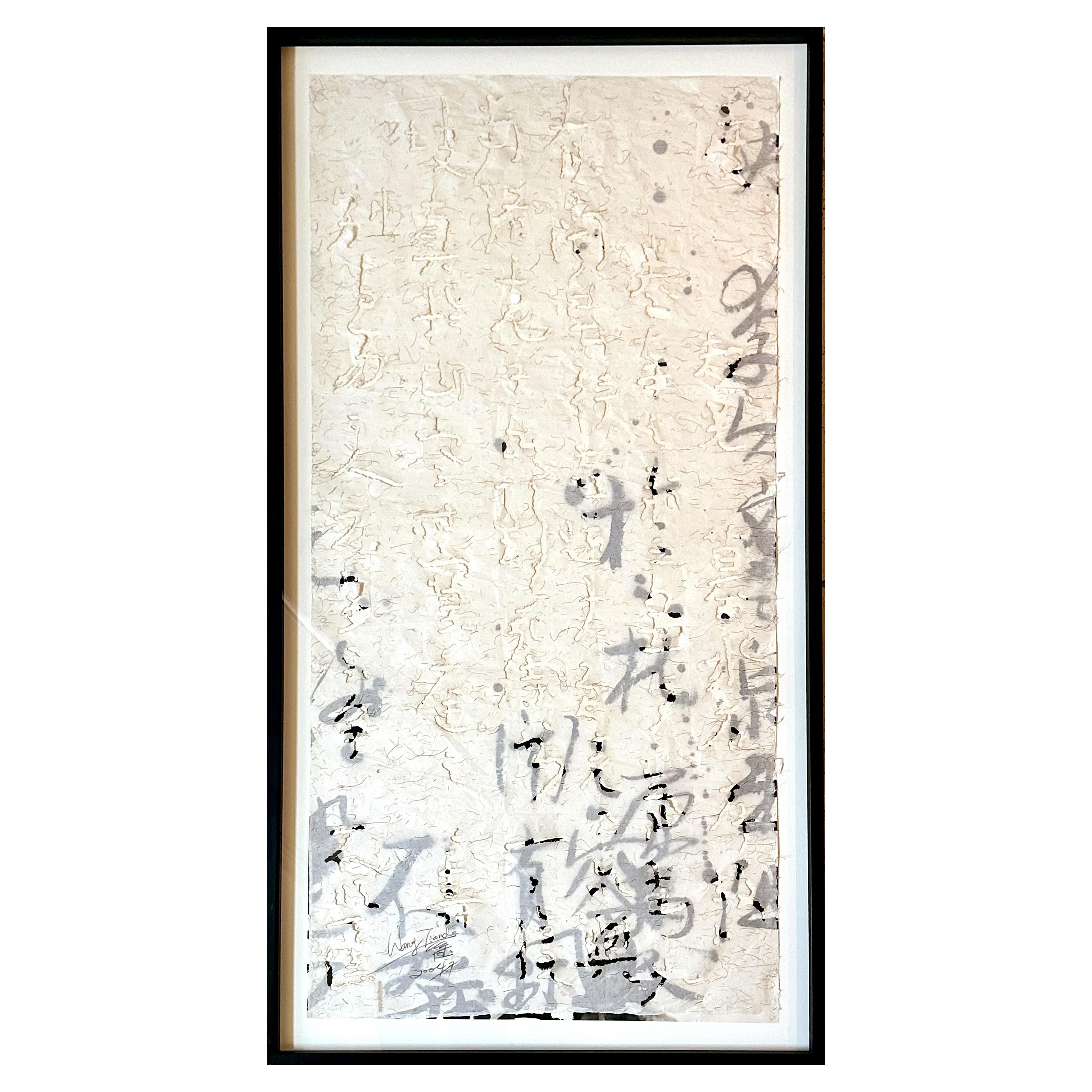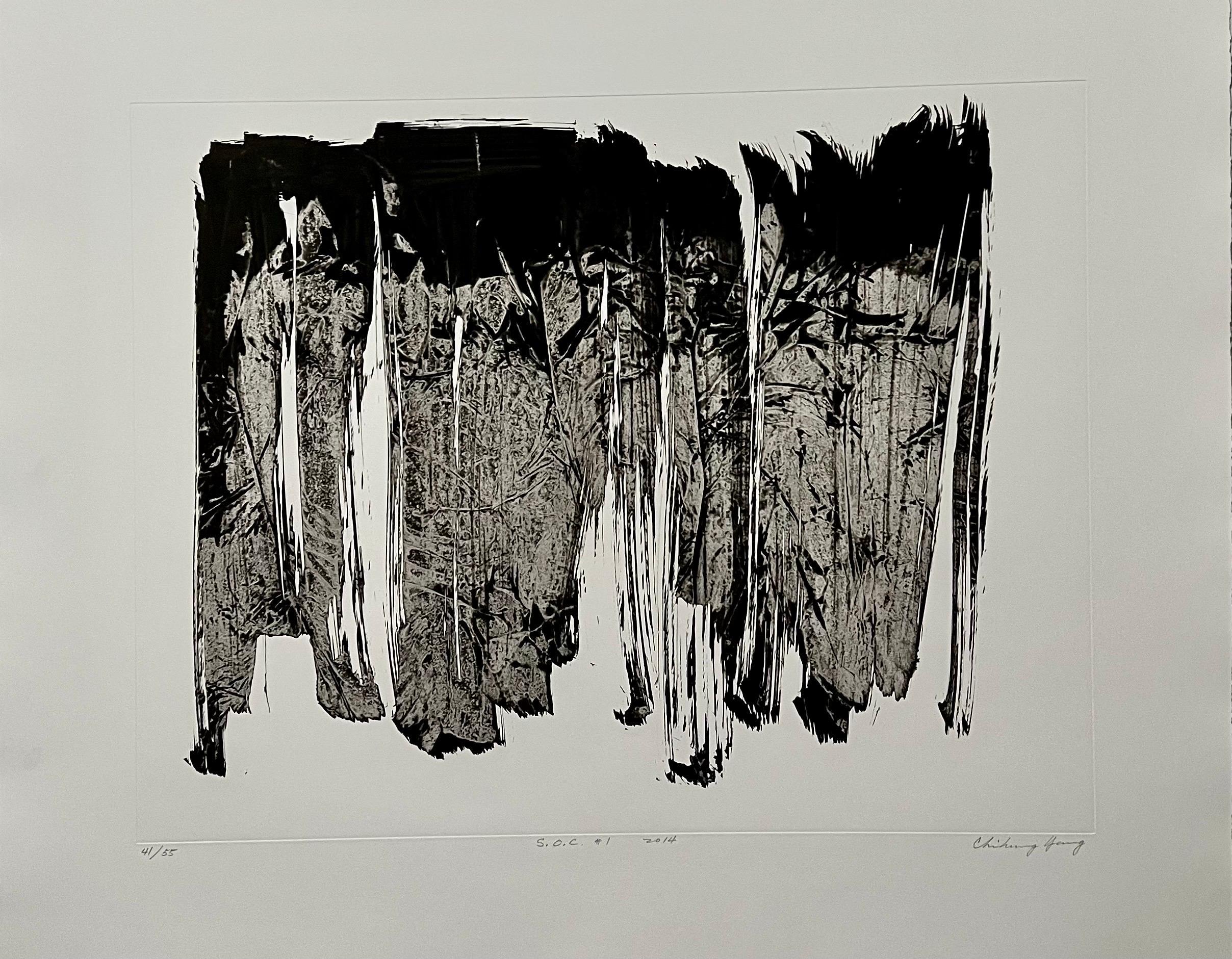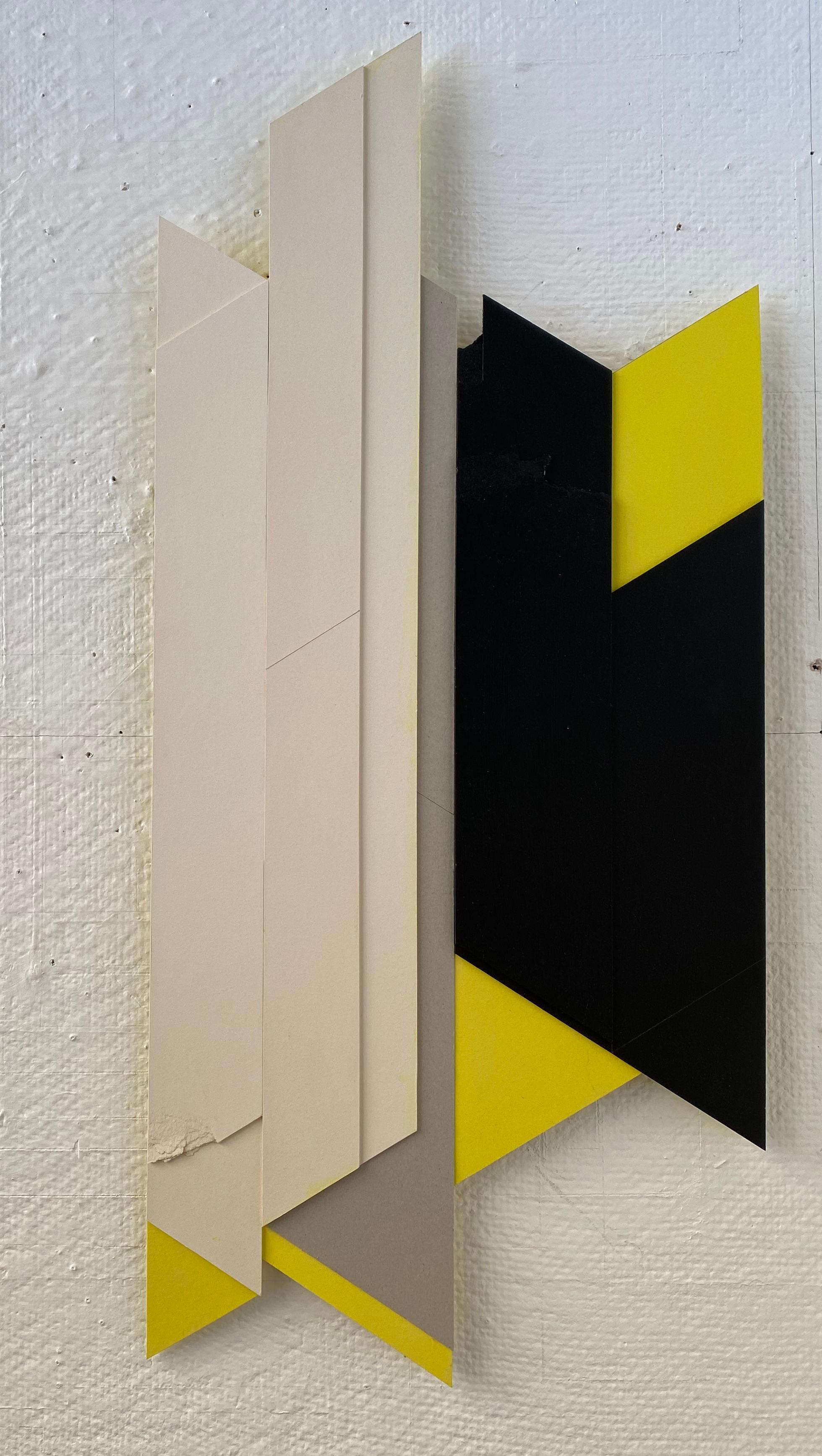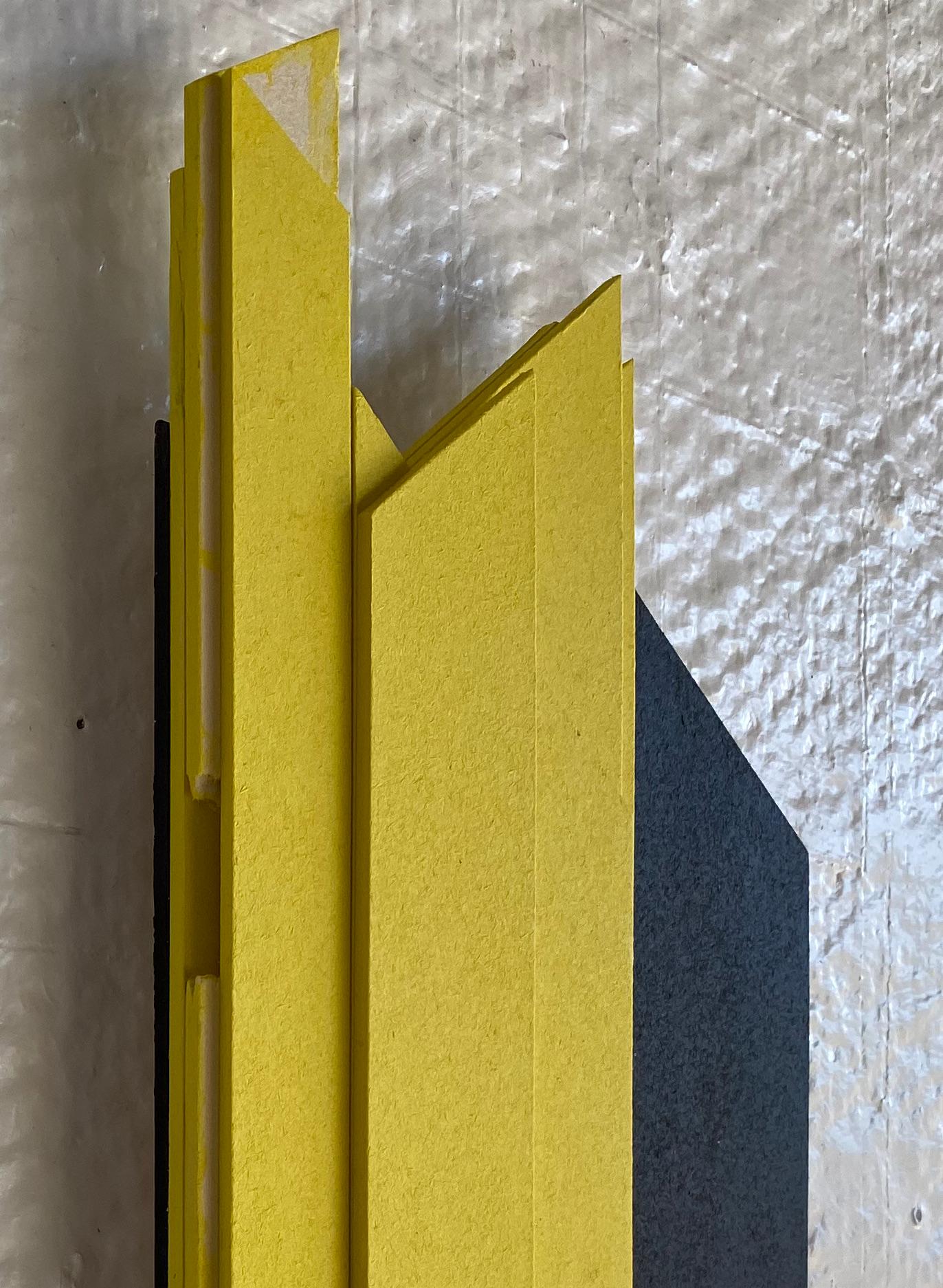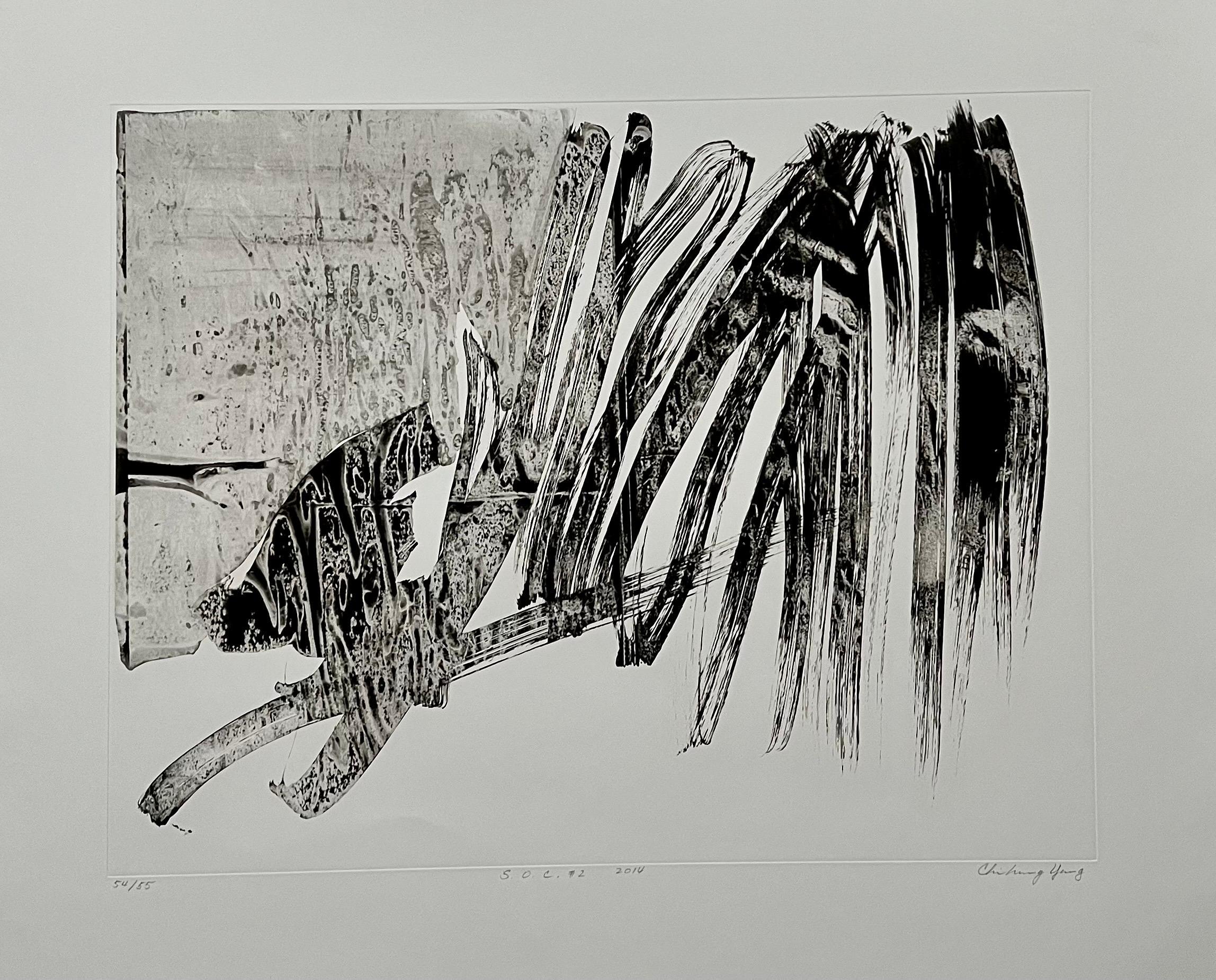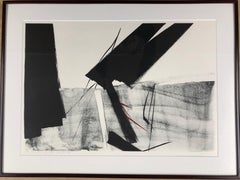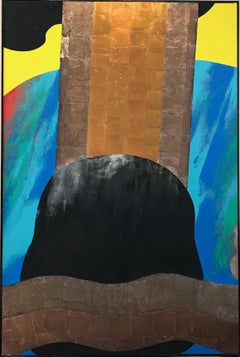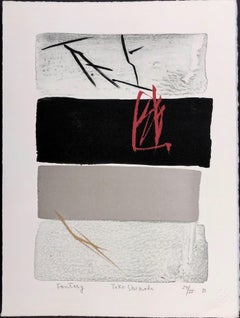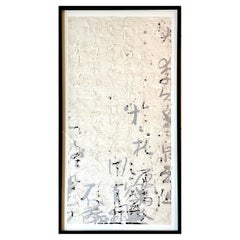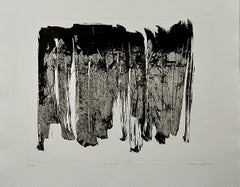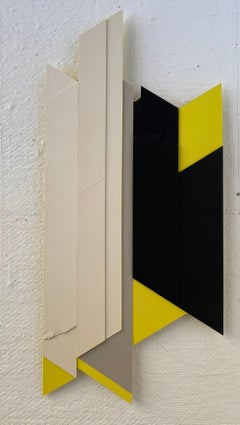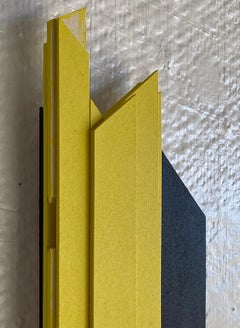Items Similar to The Beginning, 2021, cast paper, framed sculpture, black, Chinese text
Want more images or videos?
Request additional images or videos from the seller
1 of 8
Cheung Yee (Zhang Yi)The Beginning, 2021, cast paper, framed sculpture, black, Chinese text1974
1974
$6,200
£4,661.90
€5,413.60
CA$8,658.17
A$9,602.55
CHF 5,042.79
MX$117,926.16
NOK 63,836.92
SEK 60,199.07
DKK 40,391.39
Shipping
Retrieving quote...The 1stDibs Promise:
Authenticity Guarantee,
Money-Back Guarantee,
24-Hour Cancellation
About the Item
Cheung Yee, Cast Paper painting, wall sculpture, black, edition
CHEUNG YEE (1936–2019)
The Chinese artist Cheung Yee, a pioneer of the contemporary art scene in Hong Kong, died in Los Angeles on December 4 at the age of eighty-three. The Hong Kong Museum of Art confirmed his passing. Best known for his paper castings; bronze relief; and wooden, stone, and bronze sculptures, which mixed Western modernism, traditional Chinese aesthetics, and elements of folklore and ancient philosophies, Cheung cofounded the avant-garde Circle Art Group with Hon Chi Fun, Wucius Wong, and several other peers. The group was active from 1964 to 1971.
Born in Guangzhou, China, in 1936, Cheung was raised in Hong Kong but was forced to leave the region when the Japanese invaded China during the Second Sino-Japanese War; his family relocated to Guangzhou. When the conflict ended, Cheung returned to the region and began learning Gongbi, a realist brush technique in Chinese painting. In the 1950s, he studied art at Taiwan Normal University in Taipei, where he met his wife. Throughout his schooling, Cheung pursued his interests in archaeology and began experimenting with different materials and with approaches to copperplate etching, welding, and modeling.
In 1964, Cheung’s first major retrospective was organized by the City Museum and Art Gallery at Hong Kong City Hall. The following year, he received a grant from the Institute of International Education to study in the United States and Europe. Since then, he has had solo exhibitions at the Hong Kong Museum of Art, AO Vertical Art Space, and Galerie Du Monde in Hong Kong and at iPreciation in Singapore. In the 1980s, the artist started his series of iconic bronze crab sculptures, two of which can be found outside of the Space Museum Art and in the sculptural walk in Kowloon Park in Hong Kong.
In 1979, Cheung was designated a Member of the Order of the British Empire. He also received the Hong Kong Annual Sculpture Award in 1988. An advocate of the local arts scene, Cheung taught in the department of design at Polytechnic University in Hong Kong and at the Chinese University of Hong Kong, where he served as chair of the department of fine arts from 1984 to 1992. After retiring in 1998, he moved to California where he continued to work.
“I think the great achievement is when you create something out of nothing,” Cheung said in an interview in May 2019. “One time, I gave my students a piece of white paper. Someone complained that they had no tools to make art but I told them, you can use your hands to fold the paper, to crush it, your saliva to wet it. In my eyes, nothing is garbage. Garbage is man-made, nothing is naturally junk.”
Cheung’s works can be found in the public collections of the Hong Kong Museum of Art; the Museum of Modern Art, Mexico City; the National Museum of History, Taipei; the Taipei Fine Arts Museum, Taiwan; and the Kaohsiung Fine Arts Museum, Taiwan. - Artforum Magazine
- Creator:Cheung Yee (Zhang Yi) (1936, Chinese)
- Creation Year:1974
- Dimensions:Height: 24.5 in (62.23 cm)Width: 24 in (60.96 cm)
- Medium:
- Movement & Style:
- Period:
- Condition:
- Gallery Location:Santa Fe, NM
- Reference Number:1stDibs: LU19127478752
About the Seller
4.9
Vetted Professional Seller
Every seller passes strict standards for authenticity and reliability
Established in 1966
1stDibs seller since 2015
99 sales on 1stDibs
Typical response time: 1 hour
- ShippingRetrieving quote...Shipping from: Santa Fe, NM
- Return Policy
Authenticity Guarantee
In the unlikely event there’s an issue with an item’s authenticity, contact us within 1 year for a full refund. DetailsMoney-Back Guarantee
If your item is not as described, is damaged in transit, or does not arrive, contact us within 7 days for a full refund. Details24-Hour Cancellation
You have a 24-hour grace period in which to reconsider your purchase, with no questions asked.Vetted Professional Sellers
Our world-class sellers must adhere to strict standards for service and quality, maintaining the integrity of our listings.Price-Match Guarantee
If you find that a seller listed the same item for a lower price elsewhere, we’ll match it.Trusted Global Delivery
Our best-in-class carrier network provides specialized shipping options worldwide, including custom delivery.More From This Seller
View AllWritings 117, Cheung Yee, handmade cast paper painting dark brown, turtle shells
By Cheung Yee (Zhang Yi)
Located in Santa Fe, NM
Writings 117, Cheung Yee, handmade cast paper painting dark brown, turtle shells
handmade cast paper painting.
Oracle bones (Chinese: 甲骨; pinyin: ...
Category
1980s Contemporary Mixed Media
Materials
Handmade Paper
Through The Ages by Toko Shinoda, black and white signed lithograph calligraphy
By Toko Shinoda
Located in Santa Fe, NM
Through The Ages by Toko Shinoda, black and white signed lithograph calligraphy 11/35
obituary published by CNN March 2021
Celebra...
Category
1990s Contemporary Abstract Prints
Materials
Lithograph
Revelation, Kenji Yoshida, Nihonga, painting, Japan, Paris, gold, silver, black
By Kenji Yoshida
Located in Santa Fe, NM
Revelation, Kenji Yoshida, Nihonga, painting, Japan, Paris, gold, silver, black
Category
1980s Contemporary Abstract Paintings
Materials
Gold Leaf
Fantasy, Japanese, limited edition lithograph, black, white, red, signed, titled
By Toko Shinoda
Located in Santa Fe, NM
Fantasy, Japanese, limited edition lithograph, black, white, red, signed, titled
Shinoda's works have been collected by public galleries and museums, including the Museum of Modern Art, Solomon R. Guggenheim Museum, Brooklyn Museum and Metropolitan Museum (all in New York City), the National Museum of Modern Art in Tokyo, the British Museum in London, the Art Institute of Chicago, Arthur M. Sackler Gallery of the Smithsonian in Washington, D.C., the Singapore Art Museum, the National Museum of Singapore, the Kröller-Müller Museum in Otterlo, Netherlands, the Albright–Knox Art Gallery in Buffalo, New York, the Cincinnati Art Museum, and the Yale University Art Gallery in New Haven, Connecticut.
New York Times Obituary, March 3, 2021 by Margalit Fox, Alex Traub contributed reporting.
Toko Shinoda, one of the foremost Japanese artists of the 20th century, whose work married the ancient serenity of calligraphy with the modernist urgency of Abstract Expressionism, died on Monday at a hospital in Tokyo. She was 107.
Her death was announced by her gallerist in the United States.
A painter and printmaker, Ms. Shinoda attained international renown at midcentury and remained sought after by major museums and galleries worldwide for more than five decades.
Her work has been exhibited at, among other places, the Metropolitan Museum of Art and the Museum of Modern Art in New York; the Art Institute of Chicago; the British Museum; and the National Museum of Modern Art in Tokyo. Private collectors include the Japanese imperial family.
Writing about a 1998 exhibition of Ms. Shinoda’s work at a London gallery, the British newspaper The Independent called it “elegant, minimal and very, very composed,” adding, “Her roots as a calligrapher are clear, as are her connections with American art of the 1950s, but she is quite obviously a major artist in her own right.”
As a painter, Ms. Shinoda worked primarily in sumi ink, a solid form of ink, made from soot pressed into sticks, that has been used in Asia for centuries.
Rubbed on a wet stone to release their pigment, the sticks yield a subtle ink that, because it is quickly imbibed by paper, is strikingly ephemeral. The sumi artist must make each brush stroke with all due deliberation, as the nature of the medium precludes the possibility of reworking even a single line.
“The color of the ink which is produced by this method is a very delicate one,” Ms. Shinoda told The Business Times of Singapore in 2014. “It is thus necessary to finish one’s work very quickly. So the composition must be determined in my mind before I pick up the brush. Then, as they say, the painting just falls off the brush.”
Ms. Shinoda painted almost entirely in gradations of black, with occasional sepias and filmy blues. The ink sticks she used had been made for the great sumi artists of the past, some as long as 500 years ago.
Her line — fluid, elegant, impeccably placed — owed much to calligraphy. She had been rigorously trained in that discipline from the time she was a child, but she had begun to push against its confines when she was still very young.
Deeply influenced by American Abstract Expressionists like Jackson Pollock, Mark Rothko and Robert Motherwell, whose work she encountered when she lived in New York in the late 1950s, Ms. Shinoda shunned representation.
“If I have a definite idea, why paint it?,” she asked in an interview with United Press International in 1980. “It’s already understood and accepted. A stand of bamboo is more beautiful than a painting could be. Mount Fuji is more striking than any possible imitation.”
Spare and quietly powerful, making abundant use of white space, Ms. Shinoda’s paintings are done on traditional Chinese and Japanese papers, or on backgrounds of gold, silver or platinum leaf.
Often asymmetrical, they can overlay a stark geometric shape with the barest calligraphic strokes. The combined effect appears to catch and hold something evanescent — “as elusive as the memory of a pleasant scent or the movement of wind,” as she said in a 1996 interview.
Ms. Shinoda’s work also included lithographs; three-dimensional pieces of wood and other materials; and murals in public spaces, including a series made for the Zojoji Temple in Tokyo.
The fifth of seven children of a prosperous family, Ms. Shinoda was born on March 28, 1913, in Dalian, in Manchuria, where her father, Raijiro, managed a tobacco plant. Her mother, Joko, was a homemaker. The family returned to Japan when she was a baby, settling in Gifu, midway between Kyoto and Tokyo.
One of her father’s uncles, a sculptor and calligrapher, had been an official seal carver to the Meiji emperor. He conveyed his love of art and poetry to Toko’s father, who in turn passed it to Toko.
“My upbringing was a very traditional one, with relatives living with my parents,” she said in the U.P.I. interview. “In a scholarly atmosphere, I grew up knowing I wanted to make these things, to be an artist.”
She began studying calligraphy at 6, learning, hour by hour, impeccable mastery over line. But by the time she was a teenager, she had begun to seek an artistic outlet that she felt calligraphy, with its centuries-old conventions, could not afford.
“I got tired of it and decided to try my own style,” Ms. Shinoda told Time magazine in 1983. “My father always scolded me for being naughty and departing from the traditional way, but I had to do it.”
Moving to Tokyo as a young adult, Ms. Shinoda became celebrated throughout Japan as one of the country’s finest living calligraphers, at the time a signal honor for a woman. She had her first solo show in 1940, at a Tokyo gallery.
During World War II, when she forsook the city for the countryside near Mount Fuji, she earned her living as a calligrapher, but by the mid-1940s she had started experimenting with abstraction. In 1954 she began to achieve renown outside Japan with her inclusion in an exhibition of Japanese calligraphy at MoMA.
In 1956, she traveled to New York. At the time, unmarried Japanese women could obtain only three-month visas for travel abroad, but through zealous renewals, Ms. Shinoda managed to remain for two years.
She met many of the titans of Abstract Expressionism there, and she became captivated by their work.
“When I was in New York in the ’50s, I was often included in activities with those artists, people like Mark Rothko, Jackson Pollock, Motherwell and so forth,” she said in a 1998 interview with The Business Times. “They were very generous people, and I was often invited to visit their studios, where we would share ideas and opinions on our work. It was a great experience being together with people who shared common feelings.”
During this period, Ms. Shinoda’s work was sold in the United States by Betty Parsons, the New York dealer who represented Pollock, Rothko and many of their contemporaries.
Returning to Japan, Ms. Shinoda began to fuse calligraphy and the Expressionist aesthetic in earnest. The result was, in the words of The Plain Dealer of Cleveland in 1997, “an art of elegant simplicity and high drama.”
Among Ms. Shinoda’s many honors, she was depicted, in 2016, on a Japanese postage stamp. She is the only Japanese artist to be so honored during her lifetime.
No immediate family members survive.
When she was quite young and determined to pursue a life making art, Ms. Shinoda made the decision to forgo the path that seemed foreordained for women of her generation.
“I never married and have no children,” she told The Japan Times in 2017. “And I suppose that it sounds strange to think that my paintings are in place of them — of course they are not the same thing at all. But I do say, when paintings that I have made years ago are brought back into my consciousness, it seems like an old friend, or even a part of me, has come back to see me.”
Works of a Woman's Hand
Toko Shinoda bases new abstractions on ancient calligraphy
Down a winding side street in the Aoyama district, western Tokyo. into a chunky white apartment building, then up in an elevator small enough to make a handful of Western passengers friends or enemies for life. At the end of a hall on the fourth floor, to the right, stands a plain brown door. To be admitted is to go through the looking glass. Sayonara today. Hello (Konichiwa) yesterday and tomorrow.
Toko Shinoda, 70, lives and works here. She can be, when she chooses, on e of Japans foremost calligraphers, master of an intricate manner of writing that traces its lines back some 3,000 years to ancient China. She is also an avant-garde artist of international renown, whose abstract paintings and lithographs rest in museums around the world. These diverse talents do not seem to belong in the same epoch. Yet they have somehow converged in this diminutive woman who appears in her tiny foyer, offering slippers and ritual bows of greeting.
She looks like someone too proper to chip a teacup, never mind revolutionize an old and hallowed art form She wears a blue and white kimono of her own design. Its patterns, she explains, are from Edo, meaning the period of the Tokugawa shoguns, before her city was renamed Tokyo in 1868. Her black hair is pulled back from her face, which is virtually free of lines and wrinkles. except for the gold-rimmed spectacles perched low on her nose (this visionary is apparently nearsighted). Shinoda could have stepped directly from a 19th century Meji print.
Her surroundings convey a similar sense of old aesthetics, a retreat in the midst of a modern, frenetic city. The noise of the heavy traffic on a nearby elevated highway sounds at this height like distant surf. delicate bamboo shades filter the daylight. The color arrangement is restful: low ceilings of exposed wood, off-white walls, pastel rugs of blue, green and gray.
It all feels so quintessentially Japanese that Shinoda’s opening remarks come as a surprise. She points out (through a translator) that she was not born in Japan at all but in Darien, Manchuria. Her father had been posted there to manage a tobacco company under the aegis of the occupying Japanese forces, which seized the region from Russia in 1905. She says,”People born in foreign places are very free in their thinking, not restricted” But since her family went back to Japan in 1915, when she was two, she could hardly remember much about a liberated childhood? She answers,”I think that if my mother had remained in Japan, she would have been an ordinary Japanese housewife. Going to Manchuria, she was able to assert her own personality, and that left its mark on me.”
Evidently so. She wears her obi low on the hips, masculine style. The Porcelain aloofness she displays in photographs shatters in person. Her speech is forceful, her expression animated and her laugh both throaty and infectious. The hand she brings to her mouth to cover her amusement (a traditional female gesture of modesty) does not stand a chance.
Her father also made a strong impression on the fifth of his seven children:”He came from a very old family, and he was quite strict in some ways and quite liberal in others.” He owned one of the first three bicycles ever imported to Japan and tinkered with it constantly He also decided that his little daughter would undergo rigorous training in a procrustean antiquity.
“I was forced to study from age six on to learn calligraphy,” Shinoda says, The young girl dutifully memorized and copied the accepted models. In one sense, her father had pushed her in a promising direction, one of the few professional fields in Japan open to females. Included among the ancient terms that had evolved around calligraphy was onnade, or woman's writing.
Heresy lay ahead. By the time she was 15, she had already been through nine years of intensive discipline, “I got tired of it and decided to try my own style. My father always scolded me for being naughty and departing from the traditional way, but I had to do it.”
She produces a brush and a piece of paper to demonstrate the nature of her rebellion. “This is kawa, the accepted calligraphic character for river,” she says, deftly sketching three short vertical strokes. “But I wanted to use more than three lines to show the force of the river.” Her brush flows across the white page, leaving a recognizable river behind, also flowing.” The simple kawa in the traditional language was not enough for me. I wanted to find a new symbol to express the word river.”
Her conviction grew that ink could convey the ineffable, the feeling, "as she says, of wind blowing softly.” Another demonstration. She goes to the sliding wooden door of an anteroom and disappears in back of it; the only trace of her is a triangular swatch of the right sleeve of her kimono, which she has arranged for that purpose. A realization dawns. The task of this artist is to paint that three sided pattern so that the invisible woman attached to it will be manifest to all viewers.
Gen, painted especially for TIME, shows Shinoda’s theory in practice. She calls the work “my conception of Japan in visual terms.” A dark swath at the left, punctuated by red, stands for history. In the center sits a Chinese character gen, which means in the present or actuality. A blank pattern at the right suggests an unknown future.
Once out of school, Shinoda struck off on a path significantly at odds with her culture. She recognized marriage for what it could mean to her career (“a restriction”) and decided against it. There was a living to be earned by doing traditional calligraphy:she used her free time to paint her variations. In 1940 a Tokyo gallery exhibited her work. (Fourteen years would pass before she got a second show.)War came, and bad times for nearly everyone, including the aspiring artist , who retreated to a rural area near Mount Fuji and traded her kimonos for eggs.
In 1954 Shinoda’s work was included in a group exhibit at New York City’s Museum of Modern Art. Two years later, she overcame bureaucratic obstacles to visit the U.S.. Unmarried Japanese women are allowed visas for only three months, patiently applying for two-month extensions, one at a time, Shinoda managed to travel the country for two years. She pulls out a scrapbook from this period. Leafing through it, she suddenly raises a hand and touches her cheek:”How young I looked!” An inspection is called for. The woman in the grainy, yellowing newspaper photograph could easily be the on e sitting in this room. Told this, she nods and smiles. No translation necessary.
Her sojourn in the U.S. proved to be crucial in the recognition and development of Shinoda’s art. Celebrities such as actor Charles Laughton and John Lewis of the Modern Jazz Quartet bought her paintings and spread the good word. She also saw the works of the abstract expressionists, then the rage of the New York City art world, and realized that these Western artists, coming out of an utterly different tradition, were struggling toward the same goal that had obsessed her. Once she was back home, her work slowly made her famous.
Although Shinoda has used many materials (fabric, stainless steel, ceramics, cement), brush and ink remain her principal means of expression. She had said, “As long as I am devoted to the creation of new forms, I can draw even with muddy water.” Fortunately, she does not have to. She points with evident pride to her ink stone, a velvety black slab of rock, with an indented basin, that is roughly a foot across and two feet long. It is more than 300 years old. Every working morning, Shinoda pours about a third of a pint of water into it, then selects an ink stick from her extensive collection, some dating back to China’s Ming dynasty. Pressing stick against stone, she begins rubbing. Slowly, the dried ink dissolves in the water and becomes ready for the brush. So two batches of sumi (India ink) are exactly alike; something old, something new. She uses color sparingly. Her clear preference is black and all its gradations. “In some paintings, sumi expresses blue better than blue.”
It is time to go downstairs to the living quarters. A niece, divorced and her daughter,10,stay here with Shinoda; the artist who felt forced to renounce family and domesticity at the outset of her career seems welcome to it now. Sake is offered, poured into small cedar boxes and happily accepted. Hold carefully. Drink from a corner. Ambrosial. And just right for the surroundings and the hostess. A conservative renegade; a liberal traditionalist; a woman steeped in the male-dominated conventions that she consistently opposed. Her trail blazing accomplishments are analogous to Picasso’s.
When she says goodbye, she bows. --by Paul Gray...
Category
1990s Contemporary Abstract Prints
Materials
Lithograph
Tableau, Japanese, limited edition lithograph, black, white, red, signed, number
By Toko Shinoda
Located in Santa Fe, NM
Tableau, Japanese, limited edition lithograph, black, white, red, signed, number
Shinoda's works have been collected by public galleries and museums, including the Museum of Modern Art, Solomon R. Guggenheim Museum, Brooklyn Museum and Metropolitan Museum (all in New York City), the National Museum of Modern Art in Tokyo, the British Museum in London, the Art Institute of Chicago, Arthur M. Sackler Gallery of the Smithsonian in Washington, D.C., the Singapore Art Museum, the National Museum of Singapore, the Kröller-Müller Museum in Otterlo, Netherlands, the Albright–Knox Art Gallery in Buffalo, New York, the Cincinnati Art Museum, and the Yale University Art Gallery in New Haven, Connecticut.
New York Times Obituary, March 3, 2021 by Margalit Fox, Alex Traub contributed reporting.
Toko Shinoda, one of the foremost Japanese artists of the 20th century, whose work married the ancient serenity of calligraphy with the modernist urgency of Abstract Expressionism, died on Monday at a hospital in Tokyo. She was 107.
Her death was announced by her gallerist in the United States.
A painter and printmaker, Ms. Shinoda attained international renown at midcentury and remained sought after by major museums and galleries worldwide for more than five decades.
Her work has been exhibited at, among other places, the Metropolitan Museum of Art and the Museum of Modern Art in New York; the Art Institute of Chicago; the British Museum; and the National Museum of Modern Art in Tokyo. Private collectors include the Japanese imperial family.
Writing about a 1998 exhibition of Ms. Shinoda’s work at a London gallery, the British newspaper The Independent called it “elegant, minimal and very, very composed,” adding, “Her roots as a calligrapher are clear, as are her connections with American art of the 1950s, but she is quite obviously a major artist in her own right.”
As a painter, Ms. Shinoda worked primarily in sumi ink, a solid form of ink, made from soot pressed into sticks, that has been used in Asia for centuries.
Rubbed on a wet stone to release their pigment, the sticks yield a subtle ink that, because it is quickly imbibed by paper, is strikingly ephemeral. The sumi artist must make each brush stroke with all due deliberation, as the nature of the medium precludes the possibility of reworking even a single line.
“The color of the ink which is produced by this method is a very delicate one,” Ms. Shinoda told The Business Times of Singapore in 2014. “It is thus necessary to finish one’s work very quickly. So the composition must be determined in my mind before I pick up the brush. Then, as they say, the painting just falls off the brush.”
Ms. Shinoda painted almost entirely in gradations of black, with occasional sepias and filmy blues. The ink sticks she used had been made for the great sumi artists of the past, some as long as 500 years ago.
Her line — fluid, elegant, impeccably placed — owed much to calligraphy. She had been rigorously trained in that discipline from the time she was a child, but she had begun to push against its confines when she was still very young.
Deeply influenced by American Abstract Expressionists like Jackson Pollock, Mark Rothko and Robert Motherwell, whose work she encountered when she lived in New York in the late 1950s, Ms. Shinoda shunned representation.
“If I have a definite idea, why paint it?,” she asked in an interview with United Press International in 1980. “It’s already understood and accepted. A stand of bamboo is more beautiful than a painting could be. Mount Fuji is more striking than any possible imitation.”
Spare and quietly powerful, making abundant use of white space, Ms. Shinoda’s paintings are done on traditional Chinese and Japanese papers, or on backgrounds of gold, silver or platinum leaf.
Often asymmetrical, they can overlay a stark geometric shape with the barest calligraphic strokes. The combined effect appears to catch and hold something evanescent — “as elusive as the memory of a pleasant scent or the movement of wind,” as she said in a 1996 interview.
Ms. Shinoda’s work also included lithographs; three-dimensional pieces of wood and other materials; and murals in public spaces, including a series made for the Zojoji Temple in Tokyo.
The fifth of seven children of a prosperous family, Ms. Shinoda was born on March 28, 1913, in Dalian, in Manchuria, where her father, Raijiro, managed a tobacco plant. Her mother, Joko, was a homemaker. The family returned to Japan when she was a baby, settling in Gifu, midway between Kyoto and Tokyo.
One of her father’s uncles, a sculptor and calligrapher, had been an official seal carver to the Meiji emperor. He conveyed his love of art and poetry to Toko’s father, who in turn passed it to Toko.
“My upbringing was a very traditional one, with relatives living with my parents,” she said in the U.P.I. interview. “In a scholarly atmosphere, I grew up knowing I wanted to make these things, to be an artist.”
She began studying calligraphy at 6, learning, hour by hour, impeccable mastery over line. But by the time she was a teenager, she had begun to seek an artistic outlet that she felt calligraphy, with its centuries-old conventions, could not afford.
“I got tired of it and decided to try my own style,” Ms. Shinoda told Time magazine in 1983. “My father always scolded me for being naughty and departing from the traditional way, but I had to do it.”
Moving to Tokyo as a young adult, Ms. Shinoda became celebrated throughout Japan as one of the country’s finest living calligraphers, at the time a signal honor for a woman. She had her first solo show in 1940, at a Tokyo gallery.
During World War II, when she forsook the city for the countryside near Mount Fuji, she earned her living as a calligrapher, but by the mid-1940s she had started experimenting with abstraction. In 1954 she began to achieve renown outside Japan with her inclusion in an exhibition of Japanese calligraphy at MoMA.
In 1956, she traveled to New York. At the time, unmarried Japanese women could obtain only three-month visas for travel abroad, but through zealous renewals, Ms. Shinoda managed to remain for two years.
She met many of the titans of Abstract Expressionism there, and she became captivated by their work.
“When I was in New York in the ’50s, I was often included in activities with those artists, people like Mark Rothko, Jackson Pollock, Motherwell and so forth,” she said in a 1998 interview with The Business Times. “They were very generous people, and I was often invited to visit their studios, where we would share ideas and opinions on our work. It was a great experience being together with people who shared common feelings.”
During this period, Ms. Shinoda’s work was sold in the United States by Betty Parsons, the New York dealer who represented Pollock, Rothko and many of their contemporaries.
Returning to Japan, Ms. Shinoda began to fuse calligraphy and the Expressionist aesthetic in earnest. The result was, in the words of The Plain Dealer of Cleveland in 1997, “an art of elegant simplicity and high drama.”
Among Ms. Shinoda’s many honors, she was depicted, in 2016, on a Japanese postage stamp. She is the only Japanese artist to be so honored during her lifetime.
No immediate family members survive.
When she was quite young and determined to pursue a life making art, Ms. Shinoda made the decision to forgo the path that seemed foreordained for women of her generation.
“I never married and have no children,” she told The Japan Times in 2017. “And I suppose that it sounds strange to think that my paintings are in place of them — of course they are not the same thing at all. But I do say, when paintings that I have made years ago are brought back into my consciousness, it seems like an old friend, or even a part of me, has come back to see me.”
Works of a Woman's Hand
Toko Shinoda bases new abstractions on ancient calligraphy
Down a winding side street in the Aoyama district, western Tokyo. into a chunky white apartment building, then up in an elevator small enough to make a handful of Western passengers friends or enemies for life. At the end of a hall on the fourth floor, to the right, stands a plain brown door. To be admitted is to go through the looking glass. Sayonara today. Hello (Konichiwa) yesterday and tomorrow.
Toko Shinoda, 70, lives and works here. She can be, when she chooses, on e of Japans foremost calligraphers, master of an intricate manner of writing that traces its lines back some 3,000 years to ancient China. She is also an avant-garde artist of international renown, whose abstract paintings and lithographs rest in museums around the world. These diverse talents do not seem to belong in the same epoch. Yet they have somehow converged in this diminutive woman who appears in her tiny foyer, offering slippers and ritual bows of greeting.
She looks like someone too proper to chip a teacup, never mind revolutionize an old and hallowed art form She wears a blue and white kimono of her own design. Its patterns, she explains, are from Edo, meaning the period of the Tokugawa shoguns, before her city was renamed Tokyo in 1868. Her black hair is pulled back from her face, which is virtually free of lines and wrinkles. except for the gold-rimmed spectacles perched low on her nose (this visionary is apparently nearsighted). Shinoda could have stepped directly from a 19th century Meji print.
Her surroundings convey a similar sense of old aesthetics, a retreat in the midst of a modern, frenetic city. The noise of the heavy traffic on a nearby elevated highway sounds at this height like distant surf. delicate bamboo shades filter the daylight. The color arrangement is restful: low ceilings of exposed wood, off-white walls, pastel rugs of blue, green and gray.
It all feels so quintessentially Japanese that Shinoda’s opening remarks come as a surprise. She points out (through a translator) that she was not born in Japan at all but in Darien, Manchuria. Her father had been posted there to manage a tobacco company under the aegis of the occupying Japanese forces, which seized the region from Russia in 1905. She says,”People born in foreign places are very free in their thinking, not restricted” But since her family went back to Japan in 1915, when she was two, she could hardly remember much about a liberated childhood? She answers,”I think that if my mother had remained in Japan, she would have been an ordinary Japanese housewife. Going to Manchuria, she was able to assert her own personality, and that left its mark on me.”
Evidently so. She wears her obi low on the hips, masculine style. The Porcelain aloofness she displays in photographs shatters in person. Her speech is forceful, her expression animated and her laugh both throaty and infectious. The hand she brings to her mouth to cover her amusement (a traditional female gesture of modesty) does not stand a chance.
Her father also made a strong impression on the fifth of his seven children:”He came from a very old family, and he was quite strict in some ways and quite liberal in others.” He owned one of the first three bicycles ever imported to Japan and tinkered with it constantly He also decided that his little daughter would undergo rigorous training in a procrustean antiquity.
“I was forced to study from age six on to learn calligraphy,” Shinoda says, The young girl dutifully memorized and copied the accepted models. In one sense, her father had pushed her in a promising direction, one of the few professional fields in Japan open to females. Included among the ancient terms that had evolved around calligraphy was onnade, or woman's writing.
Heresy lay ahead. By the time she was 15, she had already been through nine years of intensive discipline, “I got tired of it and decided to try my own style. My father always scolded me for being naughty and departing from the traditional way, but I had to do it.”
She produces a brush and a piece of paper to demonstrate the nature of her rebellion. “This is kawa, the accepted calligraphic character for river,” she says, deftly sketching three short vertical strokes. “But I wanted to use more than three lines to show the force of the river.” Her brush flows across the white page, leaving a recognizable river behind, also flowing.” The simple kawa in the traditional language was not enough for me. I wanted to find a new symbol to express the word river.”
Her conviction grew that ink could convey the ineffable, the feeling, "as she says, of wind blowing softly.” Another demonstration. She goes to the sliding wooden door of an anteroom and disappears in back of it; the only trace of her is a triangular swatch of the right sleeve of her kimono, which she has arranged for that purpose. A realization dawns. The task of this artist is to paint that three sided pattern so that the invisible woman attached to it will be manifest to all viewers.
Gen, painted especially for TIME, shows Shinoda’s theory in practice. She calls the work “my conception of Japan in visual terms.” A dark swath at the left, punctuated by red, stands for history. In the center sits a Chinese character gen, which means in the present or actuality. A blank pattern at the right suggests an unknown future.
Once out of school, Shinoda struck off on a path significantly at odds with her culture. She recognized marriage for what it could mean to her career (“a restriction”) and decided against it. There was a living to be earned by doing traditional calligraphy:she used her free time to paint her variations. In 1940 a Tokyo gallery exhibited her work. (Fourteen years would pass before she got a second show.)War came, and bad times for nearly everyone, including the aspiring artist , who retreated to a rural area near Mount Fuji and traded her kimonos for eggs.
In 1954 Shinoda’s work was included in a group exhibit at New York City’s Museum of Modern Art. Two years later, she overcame bureaucratic obstacles to visit the U.S.. Unmarried Japanese women are allowed visas for only three months, patiently applying for two-month extensions, one at a time, Shinoda managed to travel the country for two years. She pulls out a scrapbook from this period. Leafing through it, she suddenly raises a hand and touches her cheek:”How young I looked!” An inspection is called for. The woman in the grainy, yellowing newspaper photograph could easily be the on e sitting in this room. Told this, she nods and smiles. No translation necessary.
Her sojourn in the U.S. proved to be crucial in the recognition and development of Shinoda’s art. Celebrities such as actor Charles Laughton and John Lewis of the Modern Jazz Quartet bought her paintings and spread the good word. She also saw the works of the abstract expressionists, then the rage of the New York City art world, and realized that these Western artists, coming out of an utterly different tradition, were struggling toward the same goal that had obsessed her. Once she was back home, her work slowly made her famous.
Although Shinoda has used many materials (fabric, stainless steel, ceramics, cement), brush and ink remain her principal means of expression. She had said, “As long as I am devoted to the creation of new forms, I can draw even with muddy water.” Fortunately, she does not have to. She points with evident pride to her ink stone, a velvety black slab of rock, with an indented basin, that is roughly a foot across and two feet long. It is more than 300 years old. Every working morning, Shinoda pours about a third of a pint of water into it, then selects an ink stick from her extensive collection, some dating back to China’s Ming dynasty. Pressing stick against stone, she begins rubbing. Slowly, the dried ink dissolves in the water and becomes ready for the brush. So two batches of sumi (India ink) are exactly alike; something old, something new. She uses color sparingly. Her clear preference is black and all its gradations. “In some paintings, sumi expresses blue better than blue.”
It is time to go downstairs to the living quarters. A niece, divorced and her daughter,10,stay here with Shinoda; the artist who felt forced to renounce family and domesticity at the outset of her career seems welcome to it now. Sake is offered, poured into small cedar boxes and happily accepted. Hold carefully. Drink from a corner. Ambrosial. And just right for the surroundings and the hostess. A conservative renegade; a liberal traditionalist; a woman steeped in the male-dominated conventions that she consistently opposed. Her trail blazing accomplishments are analogous to Picasso’s.
When she says goodbye, she bows. --by Paul Gray...
Category
1990s Contemporary Abstract Prints
Materials
Lithograph
La Vie, by Kenji Yoshida, Nihonga, Japanese, painting, silver, black, red, gold
By Kenji Yoshida
Located in Santa Fe, NM
La Vie, by Kenji Yoshida, Nihonga, Japanese, painting, silver, black, red, gold
La Vie 58, by Kenji Yoshida Nihonga Japanese painting silver black red gold
Gold leaf, Silver leaf a...
Category
1990s Contemporary Abstract Paintings
Materials
Gold Leaf
You May Also Like
Chinese Contemporary Ink Art by Wang Tiande
Located in Atlanta, GA
Artist: Wang Tiande (Chinese b.1960)
Title: "Digital Series No.4 C07", 2004
Medium: Chinese ink on paper and cigarette burns
Signed and dated lower left Wang Tiande 2004.
Original gallery label on verso
Frame (wood shadow box under acylic): 52 3/4" x 25 3/4"
Provenance: Purchased from Michael Goedhuis, October 23, 2006
An important figure in the Chinese contemporary art scene, in the field of modern calligraphic art particularly, Wang Tiande was born in Shanghai in 1960. After graduating from the Chinese Painting Department at the Zhejiang Academy of Fine Arts in 1988, Wang received a doctoral degree in the calligraphy department of the same school. Currently, Wang is a professor at Shanghai Fudan University. His work is held in the permanent collection of many important museums across the globe, including the Metropolitan Museum of Art, the Museum of Fine Arts Boston and the British Museum.
Known for his revival and reinterpretation of Chinese calligraphy and painting...
Category
Early 2000s Chinese Modern Contemporary Art
Materials
Acrylic, Wood, Paper
Abstract Expressionist Taiwanese Etching Chihung Yang Chinese Calligraphy Art
Located in Surfside, FL
S.O.C. #1
2014
Etching
76.5 x 91cm
Yang Chihung (Chinese: 楊識宏; pinyin: Yang Chihung; born 1947) Taiwanese-American artist.
Yang Chi-hung was born on 25 October 1947, in Chungli, Taiwan. He developed an interest in art in early childhood, and found inspirations to pursue an artist career after reading Lust for Life – The Life of Vincent van Gogh, translated by poet Yu Kuang-chung, in junior high school. Between 1965 and 1968, he attended the National Taiwan College of Art, developing a sound foundation in oil painting under the tutelage of famous Taiwanese artists of the Japanese Colonial period, such as Liao Chi-chun, Li Mei-shu and Yang San-lang. Meanwhile, he actively attended events organized by the modern art groups of Taiwan, namely the Fifth Moon Group and Ton Fan Group, only to find himself both intimidated and dissatisfied with the then relatively conservative art environment in Taiwan. In 1979, he emigrated to the United States of America with his wife, Jane, and their son, Daniel. His pioneering works soon landed him the “Outstanding Asian-American Artist” award. The concept and style of abstract expressionism as represented by the works of Jackson Pollock in the 1950s had great impact on Yang’s work. With the sense of nihilism that gave rise to abstract expressionism in the post-war period, artists no longer clamored to depict the external environment, but rather chose to focus on their own inner experience. Yang Chihung embraced this spirit about the early 1990s when his style turned abstract. In 1984–85 and again in 1985–86, he was twice awarded a year's residency at The Clocktower Studio in New York City by MoMA P.S.1.
In 2013, Yang, along with Xu Bing, Zhang Huan, and Li Chen, were the four artists featured in the Discovery Channel Asia documentary series, Chineseness, a multi-series production that focused on postwar Chinese contemporary artists.
He is of the generation of artists such as Chen Tingshi, Liang Yifeng, Yang Yuyu, Pang Jiun, Yinhui Chen, Jui-Ling Hung, De-Jinn Shiy, Yong-ik Cho, Wan Chuan Chang, Kuosung Liu, Sanlang Yang, Chetsai Shen, Fu-sheng Ku, Chunxiang Zhao, Ming Ju, Ming-Che Huang, Jiutong Liu, In-Ting Ran, George Chann, Yi Hong, Tzu-Chi Yeh, Max Liu, Yi-Hsiung Chang, Che Chuang
Awards and recognition
1989, Outstanding Asian American Artist Award, by Governor of New York
1984–1986, MoMA P.S.1 National Studio Program, Residency at Clocktower Studio, New York
SELECTED GROUP EXHIBITIONS
1969 Contemporary Young Artists Exhibition, U. S. I. S. Lincoln Center, Taipei, Taiwan
1974 Asian Contemporary Art Exhibition, Ueno Museum of Art, Tokyo, Japan
1977 10 Chinese Leading Artists, Metropolitan Museum of Art, Tokyo, Japan
1978 Contemporary Chinese Art from Taiwan, Hong Kong Arts Centre, Hong Kong
1978 International Exhibition of Prints, National Museum of Modern Art, Seoul, South Korea
1979 6th British International Print Biennial, Bradford Art Galleries and Museum, England
1980 4th Miami International Print Biennial, Metropolitan Museum Coral Gables, Florida
1982 Summer Invitational, Susan Caldwell Inc, New York City
1982 Four Artists, SoHo Center for Visual Artists, New York City
1983 New Acquisitions and Trustee's Choice, The Aldrich Museum of Contemporary Art,
1983 Cleveland (UK) 6th International Drawing Biennale, Middlesbrough Art Gallery, England
1983 Dreams Demons Madness, Alternative Museum, New York City
1984 Rambunctious, Siegel Contemporary Art, New York City
1984 Invitational Painting Exhibition, Part II: Eight Imagist Painters, Siegel Contemporary Art, NYC
1984 Salvo, Ruth Siegel Ltd, New York
1984 Modern Art, Ted Greenwald Gallery, New York City
1985 Exotica, Paintings and Works on Paper, Stephen Rosenberg Gallery, New York City
1985 The Art of the 1970s and 1980s, Aldrich Museum of Contemporary Art, Ridgefield, CT
1985 Large Figurative Drawings, Virginia Museum of Fine Arts, Richmond, Virginia
1985 Studio Programs, 1984 -1985, The Institute for Art and Urban Resources, Inc,
The Clocktower, New York City
1985 Surplus, Exit Art, New York City
1985 Four Painters From New York, Janet Steinberg Gallery, San Francisco, California
1985 Harvest, Ruth Siegel Ltd, New York City
1986 The Object Revitalized, The Paine Art Center and Arboretum, Oshkosh, Wisconsin
1986 Annual Juried Exhibition '86, The Queens Museum, New York City
1986 Summer Group Show, Galleri Mustad, Sweden
1987 New Work - New York, Helander Gallery, Palm Beach, Florida
1988 The Shell: Design Spirit, Bergen Museum of Art and Science, Paramus, New Jersey
1988 Works on Paper, Nina Freudenheim Gallery, Buffalo, New York
1988 The Flower Show, Betsy Rosenfield Gallery, Chicago, Illinois
1988 Classical Myth and Imagery in Contemporary Art, The Queens Museum, Flushing, NY
1988 Continuity and Change; Five Contemporary Chinese Artists, Yale University Art Gallery
1988 First Anniversary Exhibition, Michael Walls Gallery, New York City
1989 Second Anniversary Exhibition, Michael Walls Gallery, New York City
1990 The Matter At Hand; Contemporary Drawings, UWM Art Museum, University of Wisconsin,
1991 Entr'acte, Michael Walls Gallery, New York City
1991 Taipei - New York: Confrontation of Modernism, The Taipei Fine Arts Museum. Taiwan
1991 Past Becoming Future, The Contemporary Art Gallery, Seibu, Tokyo, Japan
1992 Intimate Universe; Small-Scale Paintings By Twenty-five American Artists, Michael Walls
1993 Paper Trails; The Eidetic Image, Krannert Art Museum, University of Illinois, Champaign,
1993 Intimate Universe, Nina Freudenheim Gallery, Buffalo, New York
1994 Isn't It Romantic? On Crosby Street, New York City
1994 To enchant (blue), Cynthia McCallister Gallery/Bixler Gallery, New York City
1994 Singapore International Art Fair, Sarina Tang Fine Art, Singapore
1994 Taipei Modem Art Exhibition, The National Gallery, Bangkok, Thailand
1995 A Romantic Impulse: Seventeen American Artists, O'Hara Gallery, New York City
1995 Chinese Artists in the United States, Hong Kong Land Limited, The Rotunda, Hong Kong
1996 Taipei Modern Art Exhibition, Shanghai Museum, Shanghai, China
1996 In Full Bloom: Flower and Garden Paintings, Lizan-Tops Gallery, East Hampton, New York
1997 Intimate Universe [Revisited], Robert Steele Gallery, New York City
1997 A Thought Intercepted, California Museum of Art, Santa Rosa, California
1997 Forces of Nature, Taipei Gallery, New York City,
1997 Lizan-Tops Gallery, East Hampton, New York
1998 Asian Aesthetic, Takara/Yukiko Lunday Gallery, Houston, Texas
1998 Contemporary Art from the Overseas Chinese, Galerie Pierre, Taichung, Taiwan
1999 Looking for the Light, The Gallery on the Hudson, Irvington, New York
1999 Visions of Pluralism, National Art Museum of China, Beijing, China; Mountain Art Museum, Kaohsiung, Taiwan
2001 Fifteen Asian American Artists, Staller Center For the Arts, University at Stony Brook,
Stony Brook, New York (Artists: Arai, Tomie; Byun, Chong Gon; Huang, Wennie; Jo, Sook Jin; Kawata, Tamiko; Le, Dinh; Lee, Bing; Li, lan; Ng, Chee Wang; Rahman, Ram; Shin, Jean; Snyder, Kit-Yin; Wong, Paul; Yamaoka, Carrie; Yang, Chihung)
2001 Rain Forest/Contemporary Paintings Kaohsiung Museum of Fine Arts, Taiwan
2001 Taipei Contemporary Art Exhibition, Shanghai Art Museum, Shanghai, China
2001 Rain Forest, Taipei Gallery, Chinese Information and Culture Center, New York
2002 Rain Forest, Las Vegas Art Museum, Las Vegas
2002 Contemporary Chinese Abstraction, Guangdong Museum of Art, Guangzhou, China
2002 Contemporary Chinese Abstraction, SenJuing Museum of Art , Guangdong, China
2003 Vision, 456 Gallery and Cork Gallery / Lincoln Center, New York
2003 World Artist's Calligraphy Biennale, Son Arts Center of Jeollabuk-do, Korea
2003 Fifty Years of Post War Taiwanese Art, Chan Liu Art Museum, Taoyuan, Taiwan
2004 Salon Comparaisons, Espace Auteuil, Paris, France
2005 Kuandu Extravaganza, Kuandu Museum of Fine Arts, Taipei, Taiwan
2005 China-Korea Modern...
Category
2010s Abstract Expressionist Abstract Prints
Materials
Etching
Work N° 2 of Kevin Cheng-Feng YU
Located in Saint Ouen, FR
1) Untitled
2) Wooden cardboard, acrylic.
3) Year of creation : 2016-2017
4) 106,5X48X0,5cm and 36X16X1cm
5) signed on the back
6) Unique copy
7) 3600 euros
Category
2010s Abstract Abstract Sculptures
Materials
Acrylic Polymer
Work N° 3 of Kevin Cheng-Feng YU
Located in Saint Ouen, FR
1) Untitled
2) Wooden cardboard, acrylic
3) Year of creation : 2016
4) 38X16,6X1,7cm
5) Signed on the back
6) Unique copy
7)1100 euros
Category
2010s Abstract Abstract Sculptures
Materials
Acrylic Polymer
Chinese Contemporary Drawing by He Jinshi - The Broken Space
Located in Paris, IDF
Chinese ink on paper, possible to have a frame upon simple request
Category
2010s Contemporary Abstract Drawings and Watercolors
Materials
Paper, Ink
$2,560 Sale Price
20% Off
Abstract Expressionist Taiwanese Etching Chihung Yang Chinese Calligraphy Art
Located in Surfside, FL
S.O.C. #2
2014
Etching
76.5 x 91cm
Yang Chihung (Chinese: 楊識宏; pinyin: Yang Chihung; born 1947) Taiwanese-American artist.
Yang Chi-hung was born on 25 October 1947, in Chungli, Taiwan. He developed an interest in art in early childhood, and found inspirations to pursue an artist career after reading Lust for Life – The Life of Vincent van Gogh, translated by poet Yu Kuang-chung, in junior high school. Between 1965 and 1968, he attended the National Taiwan College of Art, developing a sound foundation in oil painting under the tutelage of famous Taiwanese artists of the Japanese Colonial period, such as Liao Chi-chun, Li Mei-shu and Yang San-lang. Meanwhile, he actively attended events organized by the modern art groups of Taiwan, namely the Fifth Moon Group and Ton Fan Group, only to find himself both intimidated and dissatisfied with the then relatively conservative art environment in Taiwan. In 1979, he emigrated to the United States of America with his wife, Jane, and their son, Daniel. His pioneering works soon landed him the “Outstanding Asian-American Artist” award. The concept and style of abstract expressionism as represented by the works of Jackson Pollock in the 1950s had great impact on Yang’s work. With the sense of nihilism that gave rise to abstract expressionism in the post-war period, artists no longer clamored to depict the external environment, but rather chose to focus on their own inner experience. Yang Chihung embraced this spirit about the early 1990s when his style turned abstract. In 1984–85 and again in 1985–86, he was twice awarded a year's residency at The Clocktower Studio in New York City by MoMA P.S.1.
In 2013, Yang, along with Xu Bing, Zhang Huan, and Li Chen, were the four artists featured in the Discovery Channel Asia documentary series, Chineseness, a multi-series production that focused on postwar Chinese contemporary artists.
He is of the generation of artists such as Chen Tingshi, Liang Yifeng, Yang Yuyu, Pang Jiun, Yinhui Chen, Jui-Ling Hung, De-Jinn Shiy, Yong-ik Cho, Wan Chuan Chang, Kuosung Liu, Sanlang Yang, Chetsai Shen, Fu-sheng Ku, Chunxiang Zhao, Ming Ju, Ming-Che Huang, Jiutong Liu, In-Ting Ran, George Chann, Yi Hong, Tzu-Chi Yeh, Max Liu, Yi-Hsiung Chang, Che Chuang
Awards and recognition
1989, Outstanding Asian American Artist Award, by Governor of New York
1984–1986, MoMA P.S.1 National Studio Program, Residency at Clocktower Studio, New York
SELECTED GROUP EXHIBITIONS
1969 Contemporary Young Artists Exhibition, U. S. I. S. Lincoln Center, Taipei, Taiwan
1974 Asian Contemporary Art Exhibition, Ueno Museum of Art, Tokyo, Japan
1977 10 Chinese Leading Artists, Metropolitan Museum of Art, Tokyo, Japan
1978 Contemporary Chinese Art from Taiwan, Hong Kong Arts Centre, Hong Kong
1978 International Exhibition of Prints, National Museum of Modern Art, Seoul, South Korea
1979 6th British International Print Biennial, Bradford Art Galleries and Museum, England
1980 4th Miami International Print Biennial, Metropolitan Museum Coral Gables, Florida
1982 Summer Invitational, Susan Caldwell Inc, New York City
1982 Four Artists, SoHo Center for Visual Artists, New York City
1983 New Acquisitions and Trustee's Choice, The Aldrich Museum of Contemporary Art,
1983 Cleveland (UK) 6th International Drawing Biennale, Middlesbrough Art Gallery, England
1983 Dreams Demons Madness, Alternative Museum, New York City
1984 Rambunctious, Siegel Contemporary Art, New York City
1984 Invitational Painting Exhibition, Part II: Eight Imagist Painters, Siegel Contemporary Art, NYC
1984 Salvo, Ruth Siegel Ltd, New York
1984 Modern Art, Ted Greenwald Gallery, New York City
1985 Exotica, Paintings and Works on Paper, Stephen Rosenberg Gallery, New York City
1985 The Art of the 1970s and 1980s, Aldrich Museum of Contemporary Art, Ridgefield, CT
1985 Large Figurative Drawings, Virginia Museum of Fine Arts, Richmond, Virginia
1985 Studio Programs, 1984 -1985, The Institute for Art and Urban Resources, Inc,
The Clocktower, New York City
1985 Surplus, Exit Art, New York City
1985 Four Painters From New York, Janet Steinberg Gallery, San Francisco, California
1985 Harvest, Ruth Siegel Ltd, New York City
1986 The Object Revitalized, The Paine Art Center and Arboretum, Oshkosh, Wisconsin
1986 Annual Juried Exhibition '86, The Queens Museum, New York City
1986 Summer Group Show, Galleri Mustad, Sweden
1987 New Work - New York, Helander Gallery, Palm Beach, Florida
1988 The Shell: Design Spirit, Bergen Museum of Art and Science, Paramus, New Jersey
1988 Works on Paper, Nina Freudenheim Gallery, Buffalo, New York
1988 The Flower Show, Betsy Rosenfield Gallery, Chicago, Illinois
1988 Classical Myth and Imagery in Contemporary Art, The Queens Museum, Flushing, NY
1988 Continuity and Change; Five Contemporary Chinese Artists, Yale University Art Gallery
1988 First Anniversary Exhibition, Michael Walls Gallery, New York City
1989 Second Anniversary Exhibition, Michael Walls Gallery, New York City
1990 The Matter At Hand; Contemporary Drawings, UWM Art Museum, University of Wisconsin,
1991 Entr'acte, Michael Walls Gallery, New York City
1991 Taipei - New York: Confrontation of Modernism, The Taipei Fine Arts Museum. Taiwan
1991 Past Becoming Future, The Contemporary Art Gallery, Seibu, Tokyo, Japan
1992 Intimate Universe; Small-Scale Paintings By Twenty-five American Artists, Michael Walls
1993 Paper Trails; The Eidetic Image, Krannert Art Museum, University of Illinois, Champaign,
1993 Intimate Universe, Nina Freudenheim Gallery, Buffalo, New York
1994 Isn't It Romantic? On Crosby Street, New York City
1994 To enchant (blue), Cynthia McCallister Gallery/Bixler Gallery, New York City
1994 Singapore International Art Fair, Sarina Tang Fine Art, Singapore
1994 Taipei Modem Art Exhibition, The National Gallery, Bangkok, Thailand
1995 A Romantic Impulse: Seventeen American Artists, O'Hara Gallery, New York City
1995 Chinese Artists in the United States, Hong Kong Land Limited, The Rotunda, Hong Kong
1996 Taipei Modern Art Exhibition, Shanghai Museum, Shanghai, China
1996 In Full Bloom: Flower and Garden Paintings, Lizan-Tops Gallery, East Hampton, New York
1997 Intimate Universe [Revisited], Robert Steele Gallery, New York City
1997 A Thought Intercepted, California Museum of Art, Santa Rosa, California
1997 Forces of Nature, Taipei Gallery, New York City,
1997 Lizan-Tops Gallery, East Hampton, New York
1998 Asian Aesthetic, Takara/Yukiko Lunday Gallery, Houston, Texas
1998 Contemporary Art from the Overseas Chinese, Galerie Pierre, Taichung, Taiwan
1999 Looking for the Light, The Gallery on the Hudson, Irvington, New York
1999 Visions of Pluralism, National Art Museum of China, Beijing, China; Mountain Art Museum, Kaohsiung, Taiwan
2001 Fifteen Asian American Artists, Staller Center For the Arts, University at Stony Brook,
Stony Brook, New York (Artists: Arai, Tomie; Byun, Chong Gon; Huang, Wennie; Jo, Sook Jin; Kawata, Tamiko; Le, Dinh; Lee, Bing; Li, lan; Ng, Chee Wang; Rahman, Ram; Shin, Jean; Snyder, Kit-Yin; Wong, Paul; Yamaoka, Carrie; Yang, Chihung)
2001 Rain Forest/Contemporary Paintings Kaohsiung Museum of Fine Arts, Taiwan
2001 Taipei Contemporary Art Exhibition, Shanghai Art Museum, Shanghai, China
2001 Rain Forest, Taipei Gallery, Chinese Information and Culture Center, New York
2002 Rain Forest, Las Vegas Art Museum, Las Vegas
2002 Contemporary Chinese Abstraction, Guangdong Museum of Art, Guangzhou, China
2002 Contemporary Chinese Abstraction, SenJuing Museum of Art , Guangdong, China
2003 Vision, 456 Gallery and Cork Gallery / Lincoln Center, New York
2003 World Artist's Calligraphy Biennale, Son Arts Center of Jeollabuk-do, Korea
2003 Fifty Years of Post War Taiwanese Art, Chan Liu Art Museum, Taoyuan, Taiwan
2004 Salon Comparaisons, Espace Auteuil, Paris, France
2005 Kuandu Extravaganza, Kuandu Museum of Fine Arts, Taipei, Taiwan
2005 China-Korea Modern...
Category
2010s Abstract Expressionist Abstract Prints
Materials
Etching
More Ways To Browse
1980s Handmade Paper Art
Wooden Vertical Sculpture
Crab Sculpture
Junk Art Sculpture
Vintage Wooden Folding Chairs
Paper Cast Relief Art
Japan Crab
Bronze Crab
Vintage Stone Crusher
Chinese Junk
Chinese Junk Art
Zhang Hong Yi
Crab Chair
Bronze China Zhang
Suzy Frelinghuysen
Tiffany And Co Poster
Tiffany Stained Glass Collectors Society
Used Concrete Pavers
